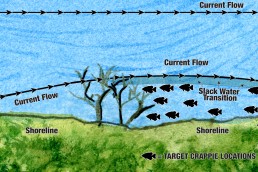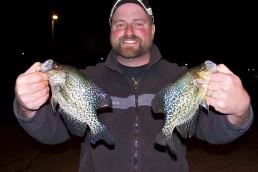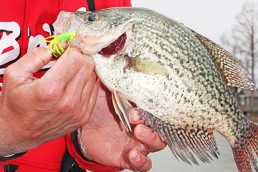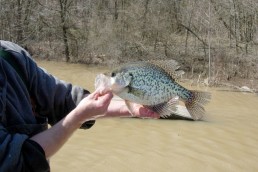The Crappie Current Connection
SHARE THIS POST
I’m always in search of patterns, more so than trying to rack up numbers of fish or size. Ending a day’s session with a bit more knowledge of fish behavior or how to make them bite trumps the desire to heft a larger stringer for the camera. New pattern development is often the result of catching a different species while in the pursuit of a targeted one.
I remember stumbling onto this new pattern for crappies while chasing down some late-season walleyes years back on the banks of the Kankakee River. I had narrowed down the walleye search to a creek arm just off the main river and my presentation to a jig and float combination. My key target spot was going to be a current break created by a logjam that had formed on some rock and concrete debris. On the first cast I maneuvered the jig and float just on the very edge of the moving water and slack water, and down goes the float and it was fish on—hmm, quite the walleye expert as I patted my own back. But after a brief fight that ended up in the main current and as I extended my hand toward the fish, I realized tugging at the end of my line was not the usual torpedo-shaped walleye but a nice flat-sided crappie.
While the walleye purist might not be as impressed by this surprise on the end of the line, being a fan of crappie fishing, I was quite pumped. I wasn’t sure if this was just a rogue crappie on the prowl for a meal, so I repeated another cast to the same spot with the same result: a crappie on the next cast and many thereafter. All the crappies caught were hanging right on the very edge of the moving water, perhaps at 10 feet back.

Now, I don’t claim to be the best river expert and l probably never will reach the esteemed title of “River Rat,” but in my river-angling experiences the area I was now catching crappies would’ve previously been my choice for either walleyes or smallmouth bass.
Then, that day’s discovery got the ol’ rusty gears turning in my brain. While there was multiple fish on this structure, was this an actual pattern or just a fluke that I found active crappies?
From that day forward I tried to develop a pattern for crappies in moving waters. While they were not new to me while fishing rivers or other moving waters, I never gave much thought to the connection between current and crappies, or more importantly, what their proximity to moving waters might be.
Previously, I pretty much narrowed my crappie chasing down to the backwater-type areas off a main river where smallies and walleyes hang on the edges of a main current, but not a spot that’s an ideal location for crappies. So my “research” took me to similar locations on both the Kankakee River and other rivers and moving-water systems. On the bodies of water I fished for crappies, there was a common thread: find a current break that creates a slack-water area, and if that slack water has some depth, there are crappies to be found.
So, let’s take a look at the current break itself.
Many objects can create this break—man-made structures such as concrete walls or bridge abutments are a possibility, and do have fish. But most of my top producers were breaks created naturally by rocks, and, while not natural, the broken concrete dumped often to control bank erosion, and finally structure created by some type of wood such as logjams or tree laydowns. These wood current breaks are golden spots; crappies just have a natural attraction to wood.
Are you enjoying this post?
You can be among the first to get the latest info on where to go, what to use and how to use it!
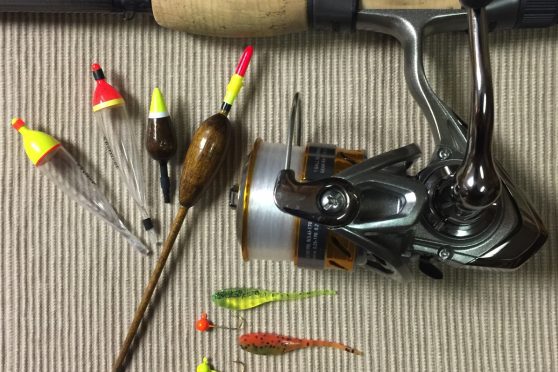
The next part of the equation was the need for some depth to the slack-water areas created by these objects. I could often find these current breaks, but for many, the slack water downstream consisted of depths of 12 inches or less. And while these spots looked good, upon investigating they just lacked the necessary depths to hold crappies. I found that 2-4 feet or more downstream of the break was the key to finding them. So, keep depth in the back of your mind, as it is critical when searching for areas that hold the active fish.
What really surprised me about my search for crappies in current was how the crappies positioned themselves in relation to the moving water that was passing by the current break. They were usually within 1 foot or less to the very edge of the moving water. My conclusion is that they faced the moving water waiting for food to be carried by in the current. When I put my bait too far behind that transition water there were no fish, but on the edge there was success.
Through trial and error, my most effective rig was a simple jig and float combination. As far as jigs, I’ve used quite a few and with crappie fishing as popular as it is, jig selection is countless. But over time I’ve picked a few favorites and still use them. I really prefer straight-tailed plastic jigs such as the Bobby Garland’s Baby Shad, Cubby’s Mini Mite and even the tiny 2-inch crappie tubes made by several manufacturers. I fish these on a 1/32-ounce jig head and will tip them with small PowerBait micros such as the Power Wigglers or some live waxies, if the bite is tuff. But for the most part, I fish just the plain plastic. Other small jigs with marabou or bucktail do work, but I’ll still opt for the plastic bodies all season. As far as color, talking with many other anglers about this it seems to be a topic with the most disagreement. Use your favorites here, but I will add that in past year orange bodies have outproduced most of my colors, but still, I’ll stick with just a few.
The other component is the float. Here, I always use sensitive European-style floats, mostly the Thill Gold Medal Series by Lindy. In moving water you want your line to attach to the float at the top. By doing this, the current will not cause the float to lie over when you’re moving it through the water. Small slip floats will work for this presentation too, but I prefer the sensitive fixed float. Thill’s Mini Shy Bite floats in these situations are a favorite of mine as well as the River Masters from Thill, though a little more difficult to locate. One float I’m really beginning to use quite a bit is the clear plastic steelhead float. These are true moving-water floats and attach to the line at the top and bottom of a float with rubber sleeves. They’re also adjustable, which is critical when fishing moving waters.
As far as a rod and reel and my setup, I use spinning gear. The one difference for me is that I fish a longer rod with medium-light action like the 9-foot 6-inch St. Croix Avid Series rod. The longer rod allows you to hold and keep your line from being carried by the current, which is critical to holding your presentation in slack water. Shorter rods can work, but I have been a fan of longer rods for years. Whatever the rod and reel you use, to get the proper jig action you’ll need line at or near 6-pound-test.
For technique, it’s simple: cast into the moving water and bring your offering into the slack water. You will know you’re in the target zone if your float stops “streaming” because of the current. From there, slowly move your jig and float through the slack water and work the entire area thoroughly, doing so from just behind the current break all the way downstream and through that slack water area. Sometimes crappies are in tight to cover and other times they’re positioned more downstream from the object creating the actual current break. And, be alert to the depth as I mentioned earlier. That prime target area is in the 2-4 feet so keep that in the back of your mind as the depth changes throughout.
Give this crappie pattern a try, use these tips and learn to experiment during your outings. Keep the “why” mentality going as you fish, and develop your own patterns. And if you find other successful ones, let me know, as I’d love to hear about any new techniques.
MWO
SHARE THIS POST
Did you enjoy this post?
You can be among the first to get the latest info on where to go, what to use and how to use it!
Dan Brozowski
Passion for angling drives Dan Brozowski to the water’s edge virtually any chance he gets. Although passion cannot be measured, weighed, or recorded, it can be shared. He does this through his writing and while on the water. If you have any questions or comments for Dan, you may contact him at: onthebank@att.net.
